Motorola Atrix HD Preview: $99 Monster?
by Jason Inofuentes on July 14, 2012 8:19 AM EST- Posted in
- Smartphones
- Qualcomm
- Motorola
- Mobile
- Atrix HD
I was reminded yesterday of the Droid RAZR launch event. One of the RAZR product managers excitedly leapt at the opportunity to run me through some benchmarks on the demo device, a rare opportunity at these sorts of events. The results were, for the time, startling. Motorola took some time to optimize the browser in ways that set it head and shoulders above the competition in some benchmarks. The result was a Sunspider score that was fully half of its predecessor the Droid Bionic.
That's how I felt as I started to run the Motorola Atrix HD through its paces yesterday. The Atrix HD softens the hard edges of the RAZR design philosophy a touch, and to good effect. The white sample we received is understated and rather pretty, though I wonder if I wouldn't have preferred an all white back, rather than that expanse of Kevlar. And inside, Motorola has moved on from the OMAP 4 that won their hearts last year and adopted Qualcomm's Snapdragon S4. Yes, the MSM8960 scores another design win.
The results we're seeing, though, are a bit odd.
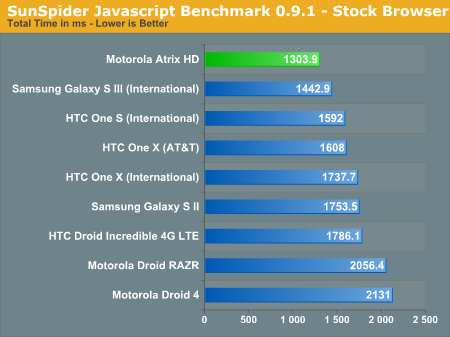
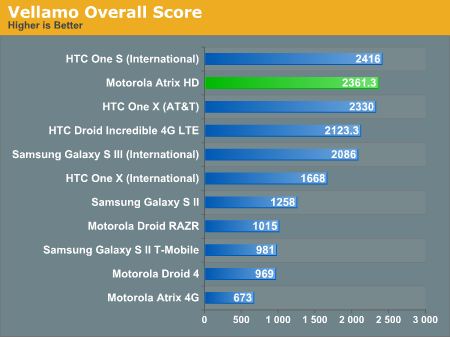
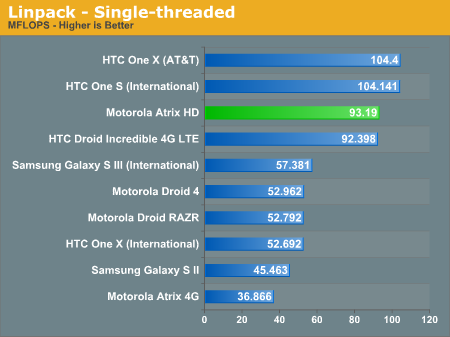
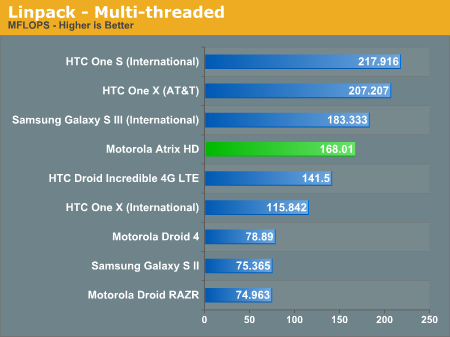
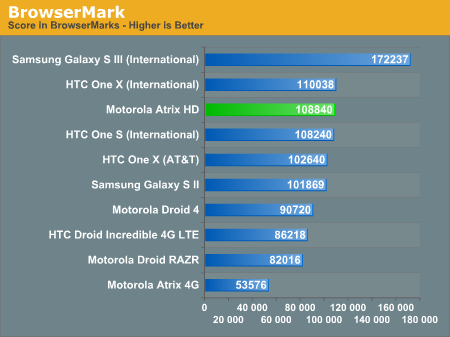

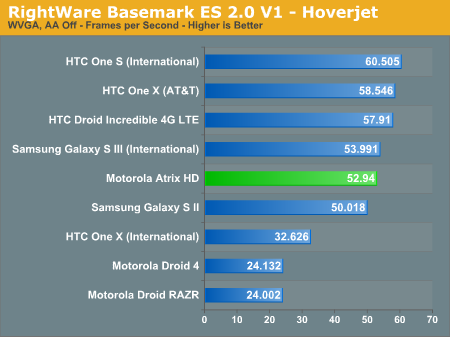

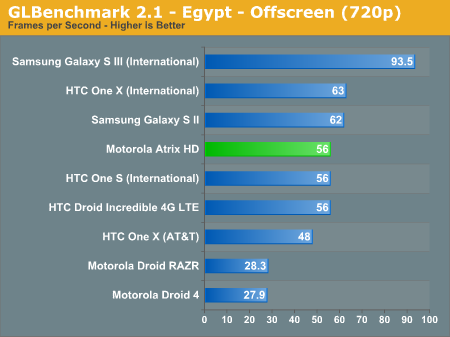
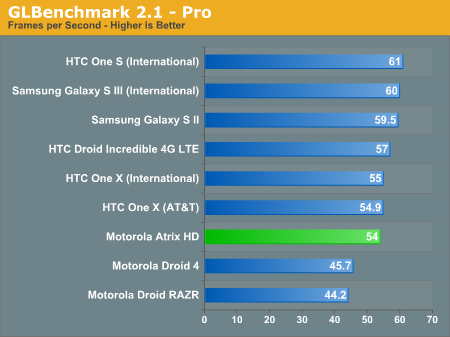
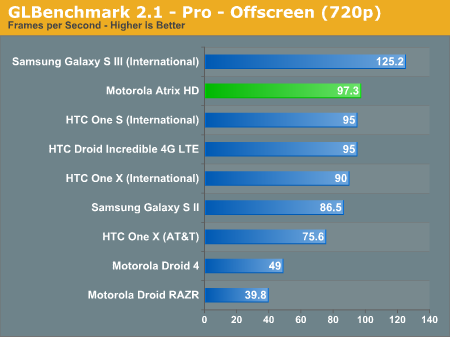
In the PC space there've been countless periods when we've had our suspicions that something sneaky was happening behind the scenes to generate extreme results in synthetic tests. I'm not suggesting Motorola's done something untoward; moreso than in the PC space, the AOSP code all OEMs start with leaves plenty of room for them to optimize to a particular hardware set-up. The numbers in the Sunspider score, though, exceed even Qualcomm's own Mobile Development Platform. Meanwhile, the rest of the benchmarks strike a much more conservative tone. We'll try and do some digging to figure out what's happening to generate these results leading up to the review. And we'll keep a close eye to see whether these synthetic results translate to real world performance.
For now, let's talk about Motorola's ICS skin, a huge departure from even the not-Blur variations we'd recently seen. All OEMs have their own clock/weather widget, and Motorola is no different, theirs is playful and features transparency effects that are oddly satisfying and allow the background to peek through. Folders work just like vanilla ICS, but home screens are laid out in a left to right fashion; and in a departure from other skins, only the main home screen is populated initially, the rest are fully absent. A swipe to the left reveals a prompt to add a blank page or one from a template. Motorola also tweaked some of the app icons, so a swipe up or down from atop the Phone icon brings up a Favorites pop-up, or Bookmarks for the Browser. This is actually a nifty way to add this functionality without cluttering your home screens with widgets, and I say kudos to Motorola for this one.
I haven't had a chance to characterize the display, but subjectively colors are bright and viewing angles are great. The body feels incredibly sturdy, as the RAZR before it, and the textured ring that goes around its edge has a pleasant tactile contrast to the smooth plastic of the rest of the frame. One note on that frame, around the display it is a glossy white plastic, but along the back it is a matte pearlescent white, not sure why the two-tone effect but it isn't jarring even when noticed. The larger screen means the excessive bezels of the RAZR are gone, while the Kevlar back continues to feel a bit out of place. We've only just begun our review process so we'll get back to it.


_575px.jpg)
_575px.jpg)
_thumb.jpg)
_thumb.jpg)
_thumb.jpg)
_thumb.jpg)
_thumb.jpg)
_thumb.jpg)








58 Comments
View All Comments
ammyt - Saturday, July 14, 2012 - link
Yep. Apparently, Tegra II sucked big time in all of the devices which featured that SoC, Tegra III, as I think, isn't much better, well except for the fact that Nvidia enabled NEON instructions allowing to decode full HD media. However, the Qualcomm SoC in the Atrix HD is a dual ARM Cortex-A15 a.k.a. Krait chipset, this SoC is really powerful, and it matches the latest quad Cortex A9s such as the Tegra III and the likes, even supersedes them in some tests, and the Adreno 320 is really good.This may be the first time I actually approve of a Qualcomm chip!
Greg512 - Saturday, July 14, 2012 - link
Krait does not actually have A15 cores, though they are more sophisticated than A9 cores. As for the GPU, I expect the Atrix to employ the Adreno 220 GPU, not the 320. The 320 has yet to find its way into any consumer device and probably won't find its way until the end of this year. Still, being the owner of a Galaxy S3 with Krait, I have to say that the chip hasn't failed me yet and, though its GPU is inferior to those in the iPhone and the (international) Samsung S3, it seems to be more than sufficient.JasonInofuentes - Saturday, July 14, 2012 - link
Just to clarify, Qualcomm's MSM8960 (found in pretty much all the new phones these days) features two Krait cores and the Adreno 225 GPU. Krait cores are NOT A15 cores, however they can be considered A15-class, they're a generational step ahead of the MSM8660's Scorpion cores in the same way Cortex-A15 will be over Cortex-A9. The Adreno 225 is based on a prior generation GPU, with the Adreno 3xx GPUs en route soon, but it's wick has been turned up for better performance over its predecessors (the 220, 205 and 200).rarson - Sunday, July 15, 2012 - link
"Krait" is a core, not a chipset. The SoC's name is "Snapdragon S4."antef - Saturday, July 14, 2012 - link
Agreed...the Galaxy Nexus is simply fantastic. Just got the OTA update to Jelly Bean today, took a couple minutes and didn't have to reinstall or reconfigure anything, after the reboot I was back at my home screen just as before, only now with Jelly Bean. Completely painless and such a difference from dealing with ROMs, Titanium Backup, etc. like I used to do with my EVO. So much time wasted on that. The Nexus also has perfectly smooth performance and great battery life, and is a steal at $349.Not only do you get a skinned out-of-date OS with a phone like the Atrix, but the bootloader will also be locked and encrypted, preventing you from ever self-upgrading with ROMs even if you wanted to. When you buy a phone like this you get complete ambiguity as to upgrade schedules with little to no options to do anything about it. That might be no big deal to a lot of people, but if you care about such things, get the Nexus.
Roland00Address - Saturday, July 14, 2012 - link
From my understanding 4.1 won't accept flash officially and it will crash if you load the app from a device that was 4.0.TareX - Saturday, July 14, 2012 - link
From what I understood, you can install any other browser with flash support and run flash as you normally would on that browser.leexgx - Saturday, July 14, 2012 - link
it mite crash on 4.1 they are just no longer developing it any moreantef - Saturday, July 14, 2012 - link
I haven't used Flash on Android for a long time. I think they were right to stop developing it.TareX - Sunday, July 15, 2012 - link
It's the only way to stream live sports without paying...